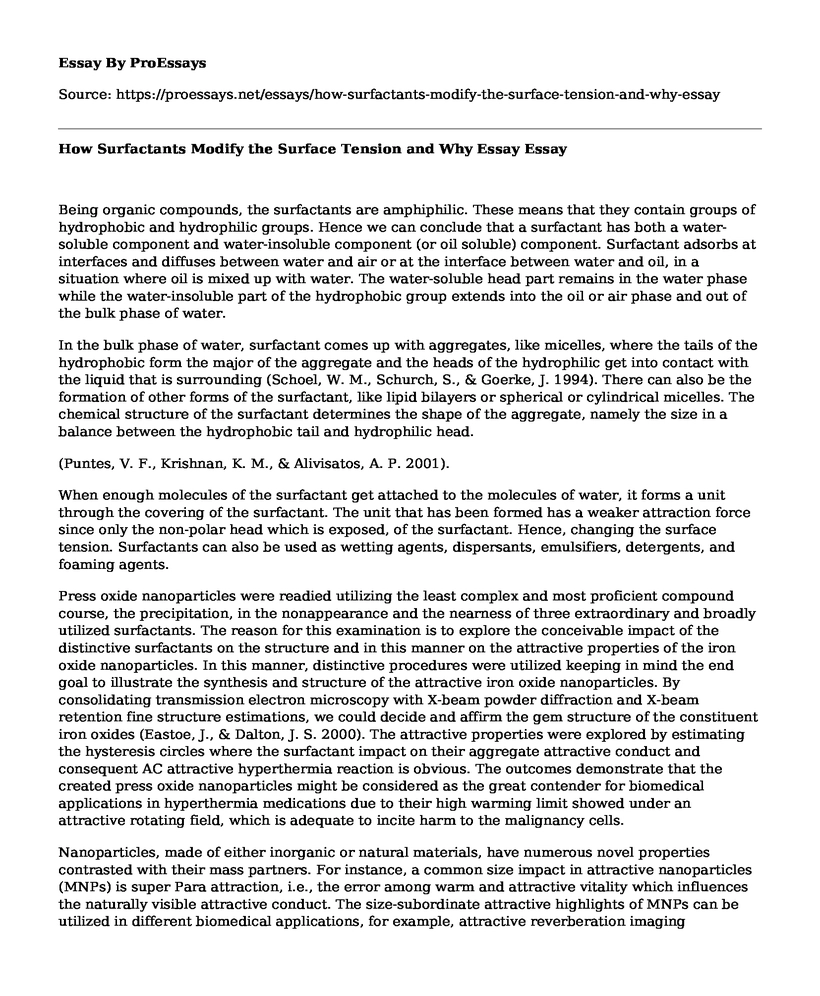Being organic compounds, the surfactants are amphiphilic. These means that they contain groups of hydrophobic and hydrophilic groups. Hence we can conclude that a surfactant has both a water-soluble component and water-insoluble component (or oil soluble) component. Surfactant adsorbs at interfaces and diffuses between water and air or at the interface between water and oil, in a situation where oil is mixed up with water. The water-soluble head part remains in the water phase while the water-insoluble part of the hydrophobic group extends into the oil or air phase and out of the bulk phase of water.
In the bulk phase of water, surfactant comes up with aggregates, like micelles, where the tails of the hydrophobic form the major of the aggregate and the heads of the hydrophilic get into contact with the liquid that is surrounding (Schoel, W. M., Schurch, S., & Goerke, J. 1994). There can also be the formation of other forms of the surfactant, like lipid bilayers or spherical or cylindrical micelles. The chemical structure of the surfactant determines the shape of the aggregate, namely the size in a balance between the hydrophobic tail and hydrophilic head.
(Puntes, V. F., Krishnan, K. M., & Alivisatos, A. P. 2001).
When enough molecules of the surfactant get attached to the molecules of water, it forms a unit through the covering of the surfactant. The unit that has been formed has a weaker attraction force since only the non-polar head which is exposed, of the surfactant. Hence, changing the surface tension. Surfactants can also be used as wetting agents, dispersants, emulsifiers, detergents, and foaming agents.
Press oxide nanoparticles were readied utilizing the least complex and most proficient compound course, the precipitation, in the nonappearance and the nearness of three extraordinary and broadly utilized surfactants. The reason for this examination is to explore the conceivable impact of the distinctive surfactants on the structure and in this manner on the attractive properties of the iron oxide nanoparticles. In this manner, distinctive procedures were utilized keeping in mind the end goal to illustrate the synthesis and structure of the attractive iron oxide nanoparticles. By consolidating transmission electron microscopy with X-beam powder diffraction and X-beam retention fine structure estimations, we could decide and affirm the gem structure of the constituent iron oxides (Eastoe, J., & Dalton, J. S. 2000). The attractive properties were explored by estimating the hysteresis circles where the surfactant impact on their aggregate attractive conduct and consequent AC attractive hyperthermia reaction is obvious. The outcomes demonstrate that the created press oxide nanoparticles might be considered as the great contender for biomedical applications in hyperthermia medications due to their high warming limit showed under an attractive rotating field, which is adequate to incite harm to the malignancy cells.
Nanoparticles, made of either inorganic or natural materials, have numerous novel properties contrasted with their mass partners. For instance, a common size impact in attractive nanoparticles (MNPs) is super Para attraction, i.e., the error among warm and attractive vitality which influences the naturally visible attractive conduct. The size-subordinate attractive highlights of MNPs can be utilized in different biomedical applications, for example, attractive reverberation imaging specialists in finding, the warm go-between in hyperthermia medications, and attractive aides in sedate conveyance (Brown, et.at 2012). These applications depend on the way that MNPs have sizes equivalent to that of the organic substances of intrigue (e.g., infections and proteins). Moreover, the peripheral surfaces of the MNPs can be effortlessly changed and additionally functionalized suitably, without saving their capacity to react to attractive outer fields.
(Eastoe, J., & Dalton, J. S. 2000).
REFERENCES
Brown, P., Bushmelev, A., Butts, C. P., Cheng, J., Eastoe, J., Grillo, I., ... & Schmidt, A. M. (2012). Magnetic control over liquid surface properties with responsive surfactants. Angewandte Chemie International Edition, 51(10), 2414-2416.
Eastoe, J., & Dalton, J. S. (2000). Dynamic surface tension and adsorption mechanisms of surfactants at the air-water interface. Advances in colloid and interface science, 85(2-3), 103-144.
Schoel, W. M., Schurch, S., & Goerke, J. (1994). The captive bubble method for the evaluation of pulmonary surfactant: surface tension, area, and volume calculations. Biochimica et Biophysica Acta (BBA)-General Subjects, 1200(3), 281-290.
Hou, Z., Li, Z., & Wang, H. (1999). Interaction between poly (ethylene oxide) and sodium dodecyl sulfonate as studied by surface tension, conductivity, viscosity, electron spin resonance, and nuclear magnetic resonance. Colloid and Polymer Science, 277(11), 1011-1018.
Puntes, V. F., Krishnan, K. M., & Alivisatos, A. P. (2001). Colloidal nanocrystal shape and size control: the case of cobalt. Science, 291(5511), 2115-2117.
Cite this page
How Surfactants Modify the Surface Tension and Why Essay. (2022, Aug 01). Retrieved from https://proessays.net/essays/how-surfactants-modify-the-surface-tension-and-why-essay
If you are the original author of this essay and no longer wish to have it published on the ProEssays website, please click below to request its removal:
- Harrison H. Schmitt and William Happer: In Defense of Carbon Dioxide
- Modeling, Simulation, and Control of an Inverted Pendulum Paper Example
- Essay Sample on Life on Mars
- Is Color a Property of the Mind or an Inherent Characteristic of Nature - Essay Sample
- Essay Example on the Physical & Chemical Characteristics of Ethanol
- Food Preservation: Retard Microbe Growth & Preserve Quality & Nutrients - Essay Example
- Essay on Gaining Global Understanding as a Step to Becoming a Conservator







